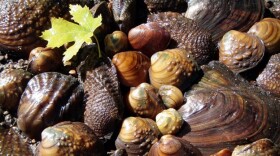On Saturday February 3rd, we were fortunate to have Becky Wiepz, Superintendent of UW-Madison’s Peninsular Agricultural Research Station, join us for our third annual Kemp Apple School. Becky covered the basics of growing apple trees in the Northwoods. Given our more severe winter climate and deer pressure, it is often difficult to successfully grow apples in the Northwoods. The course was full of questions and great ideas for participants to take back to their gardens and home orchards. I thought it would be fun to look at the amazing apple tree to see what it has done for human and animal kind over the centuries.
Apple trees are cultivated worldwide and are the most widely grown species in the genus Malus. The apple tree originated in Central Asia, where its wild ancestor, Malus sieversii, is still found. Malus domestica, the domesticated tree is in the rose family, Rosaceae. Other common plants in the rose family include pears, almonds, peaches, cherries, strawberries, and raspberries. Apples have been grown for thousands of years in Asia and Europe and were introduced to North America by European colonists. This brings us back to my last topic about exotic plants and animals (remember the ring-necked pheasant?). The apple tree is exotic in origin but is now an integral part of our landscape across North America.
The apple is thought to have been domesticated 4,000–10,000 years ago in the Tian Shan mountains, now the far western edge of modern-day China. It is expected to have travelled along the Silk Road to Europe, with hybridization between wild crabapples from Siberia and Europe as well as further cross breeding between apples as new varieties were formed. Chinese soft apples have been cultivated as dessert apples for more than 2,000 years in China and modern-day Kazakhstan to the West. Among the traits selected by human growers are size, fruit acidity, color, firmness, and soluble sugar. What is unusual for domesticated fruits is the wild apple is only slightly smaller than the modern domesticated apple. If you have ever picked a wild strawberry, you will quickly notice how tiny wild fruit is when compared to a modern cultivated strawberry.
There is indirect evidence of apple cultivation in the third millennium BCE in the Middle East. Apple cultivars brought as seed from Europe were spread along Native American trade routes, as well as being cultivated on colonial farms. By the mid 1800s, United States apples nursery catalogues sold 350 of the "best" cultivars, showing the proliferation of new North American cultivars by the 19th century. In fact it is common to find old apple trees locally, many having been planted decades ago on homesteads before people came to their senses and decided farming in the Northwoods did not make sense.
What is amazing about the common apple tree is the number of varieties. There are more than 7,500 cultivars of apples. Different cultivars are bred for various tastes and uses, including cooking, eating raw, and cider or apple juice production. Living here in the Northwoods, not all apples can handle our winters (This may sound absurd given the crazy warm weather we have had the past few weeks!). The University of Minnesota has bred numerous cold hardy varieties that can be successful in our region. Since the apple breeding program began in 1878, 29 apple varieties have been released, many of which you can purchase from local nurseries and orchards. You might recognize some of their cold hardy varieties including Zestar!®, Honeycrisp, Frostbite™, and SnowSweet®.
Many of the apple varieties available today are grafted. The scionwood (sometimes called fruitwood) is cut from a mature tree like a Honeycrisp or SnowSweet®. The scion is then grafted onto a common grafting rootstock. This provides several advantages. First you get the apple genetics of the scionwood – an exact clone of the Honeycrip or whichever tree you cut the scionwood from. Second, you will get fruit much more quickly than planting a tree from seed. The third advantage of grafting is you can control the mature size of the tree. You have probably heard the terms dwarf tree or semi-dwarf tree. In these cases, the root stock limits the growth of the scionwood producing a tree of smaller stature. The term “standard tree” is not limited by a common rootstock. Most standard-size fruit trees eventually get 25 to 30 feet tall. Dwarf and semi-dwarf fruit trees are much smaller. Fruit trees grown on dwarfing rootstocks typically grow 10 to 15 feet tall. Dwarf trees add an element of safety. They allow for easier pruning and picking closer to the ground.
If you don’t have apple trees in your yard, make sure and pay a visit to one of our local apple orchards in the late summer and fall. The amazing and exotic apple tree. It may be an exotic plant, but it is as American as apple pie.









